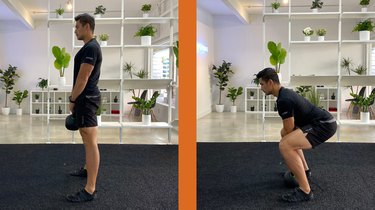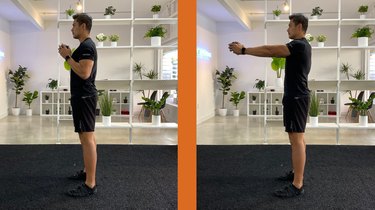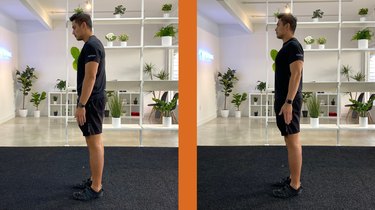
When it comes to building muscle and explosive strength, few workout tools can compare to the mighty kettlebell. But too often, poor form can make kettlebell exercises less effective — or worse, cause you pain.
To avoid getting injured, certified personal trainer Geoff Tripp, CSCS, head of fitness at Trainiac, shares the most common kettlebell mistakes people make and how to fix them. These pro tips will boost your workout and help keep you safe and pain-free.
Video of the Day
Video of the Day
1. Not Maintaining Control
"Most people just grab a kettlebell and start swinging it around," Tripp says. But think of it this way: At its most basic level, the kettlebell is a mass you're trying to control, he says.
If you lose tension in your shoulders and core as you drive into your kettlebell swings, you end up flailing wildly and relying on momentum (instead of your muscles). And whenever you do a move with poor form at a high velocity, you're bound to hurt yourself.
Fix It
Rather than letting momentum take over, be intentional with your movements. Drive through your hips and maintain tension in your whole body. According to Tripp, these little tweaks will help you control the speed of the bell and ultimately, give you a better (and safer) workout.
2. Not Driving Through Your Hips
Speaking of driving through the hips... "To say it's all in the hips is a bit of an understatement," says Tripp, who adds that most kettlebell moves involve hip action.
When you don't harness the power of your hips, you have less control over your movements, which, in turn, become less effective. Engaging your hips and glutes is especially essential for developing power when you perform a kettlebell swing.
Fix It
Tripp recommends practicing glute bridges or kettlebell deadlifts to learn what it means to get your hips under you and maintain proper tension in your muscles.
Move 1: Glute Bridge

- Lie on the ground with your knees bent, feet close to your butt and arms at your sides.
- Press into your feet and arms to lift your hips and lower and mid-back off the ground.
- Hold for 3 seconds, focusing on squeezing your glutes.
- Lower back down to the start.
Move 2: Kettlebell Deadlift

- Stand with your feet hip-width apart and a kettlebell between your feet.
- Bend your knees slightly, hinge forward at your hips and grab the kettlebell handle with both hands.
- Keeping your back flat and core tight, drive through your feet to stand as you lift the kettlebell off the ground. Squeeze your glutes and hamstrings.
- Hinge forward again, lowering the kettlebell to your shins to complete one rep.
3. Doing Too Much Too Soon
You wouldn't deadlift 350 pounds on the first try, right? Same goes for kettlebell work, Tripp says. Just because you've seen countless kettlebell swings at the gym doesn't mean you're ready to nail your own snatches and Turkish get-ups. Attempting advanced moves without proper training is a recipe for disaster — and injury.
Fix It
Put your ego aside and focus on the basics first. Tripp recommends starting with some basic drills like glute bridges, planks, core presses, push-ups and scapular retractions to train your muscles for more complex kettlebell exercises down the line.
Move 1: Core Press

- Hold a weight at your chest with a hand on either side of the handle.
- Engage your core and extend your arms straight out in front of you.
- Pause for a second, stabilizing your whole body through your core.
- Bring the weight back to your chest.
Move 2: Scapular Retraction

- Stand tall with good posture.
- Squeeze your shoulder blades toward each other without shrugging your shoulder up toward your ears.
- Relax and repeat.
Tip
You can also do scapular retractions while holding onto the ends of a resistance band (anchor the middle to a pole at chest height) or hanging from a pull-up bar.
4. Not Using Enough Weight
"Using too light of a weight doesn't produce enough muscle tension for your body to feel effort," Tripp says.
The result? If your body doesn't need to recruit and engage muscles to support a weight, the move is useless. Plus, if the weight is easy to lift, you're more likely to swing it without restraint and injure yourself (see #1 above).
Fix It
Tripp suggests slowly increasing your weight in 5- to 10-pound increments to find your sweet spot. A good rule of thumb is that the last 2 reps of an exercise should be challenging but still done with proper form.
Is this an emergency? If you are experiencing serious medical symptoms, please see the National Library of Medicine’s list of signs you need emergency medical attention or call 911.